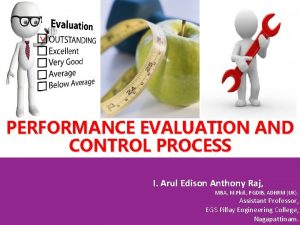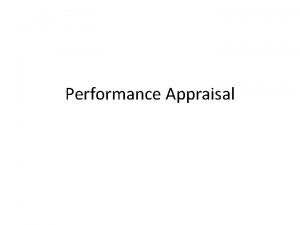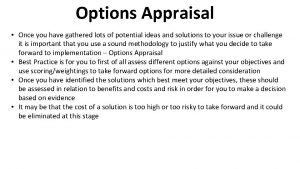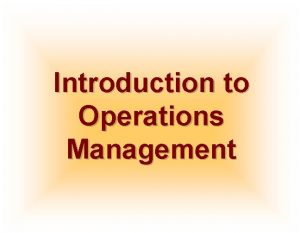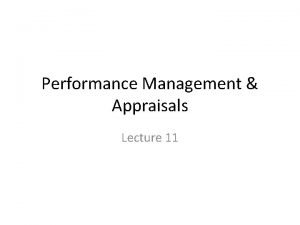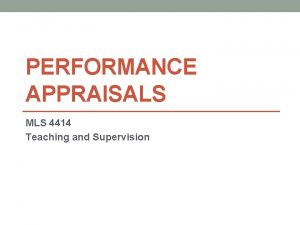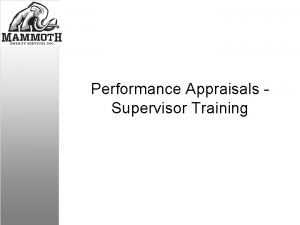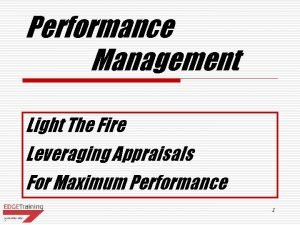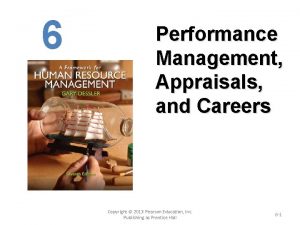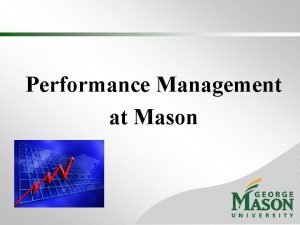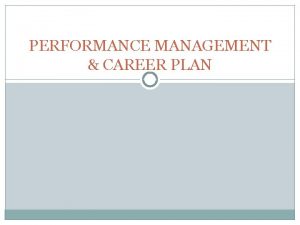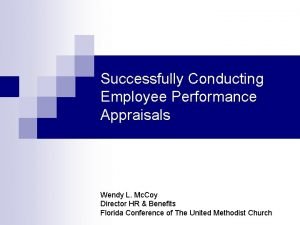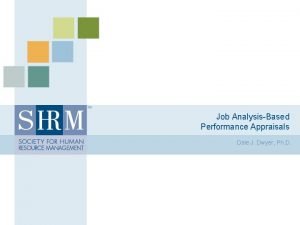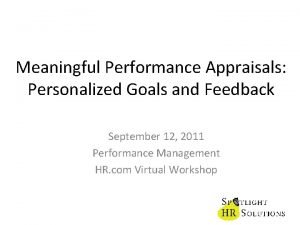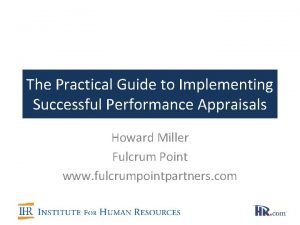Performance Management Seminar Reasons for Performance Appraisals l


























- Slides: 26

Performance Management Seminar

Reasons for Performance Appraisals l Benefits to Employees: • Provides a chance for employees to ask • • • questions and tell you their sense of what they’ve accomplished Lets employee know his/her strengths and areas that need improvement Allows employees to take responsibility for their performance Lets employees know what’s expected of them; creates mutual understand of job duties

Reasons for Performance Appraisals l Benefits to Employers: • Helps to improve employee relations and • • productivity Serves as an effective retention tool Provides a paper trail for addressing performance or disciplinary problems Demonstrates organization’s commitment to employee success Provides valuable feedback for managers

Common Problems l l l Failure to prepare for the interview Failure to listen (80 -20 ratio) Failure to maintain objectivity Failure to provide feedback—positive and/or corrective Failure to follow-up Failure to document performance – both good and bad

Common Problems l l l Misusing the performance evaluation process to address a disciplinary problem Element of surprise Relying on impressions/rumors, rather than facts Inconsistent application of performance evaluation criteria Interpersonal issues Holding employees responsible for events/problems beyond their control

Common Rater Biases l l l l Halo/horns effect Contrast effect First impressions Similar-to-me effect Negative and positive leniency tendency Spillover effect Recency effect

The Personnel-Management Cycle Job Description The Performance Appraisal Ongoing Feedback and Training

How is Your Personnel. Management Cycle? l l Do you have accurate and current job descriptions for all of your employees? Do your employees have the resources, training and information they need? Are you aware of problems that your employees have right now, for which they need help? Are you giving regular informal feedback?

Performance Appraisal Process Step 1: Prepare for the Meeting Step 2: Conduct the Meeting Step 3: Follow-up

Prepare for the Meeting l l l Review the job description to make sure it is accurate and current Gather and review any documentation Complete the performance appraisal form or narrative for the employee Review your appraisal to be sure it is objective Give the employee at least a week’s notice

Conduct the Meeting l l l Control the environment; avoid an atmosphere of stress State the purpose of the discussion Allow the employee to give their assessment of their performance Provide your own review of the employee’s performance Position criticisms as areas for improvement

Conduct the Meeting l l l l Give specific examples of strengths and areas for improvement Ask open-ended questions Be calm and objective; don’t blame or attack Focus on the performance, not the person Listen Set specific goals and timelines; action plan Close the discussion

Avoid Discriminatory Behavior l l l Avoid favoritism Base the appraisal on job-related criteria Base judgments on factual data instead of general impressions Give all employees a clear understanding of their performance standards Maintain good, accurate documentation Be consistent

Things to Remember l l l Don’t make hasty judgments. Be aware of nonverbals – yours and the employee’s Don’t be afraid of silence Don’t interrupt when the employee is speaking Use “I” statements Say what you mean

The Defensive/Hostile Employee l l l Don’t object to the employee’s reaction and become defensive Use restatement to reflect his/her negative comments Never accept abuse from an employee under any conditions Postpone the interview Have the employee prepare a written summary of his/her complaints

Follow-up l l l Provide frequent communication and feedback (positive and corrective) Maintain written records (positive and negative) Respond promptly to requests for help Conduct interim reviews • Review goals/action plans and timelines Evaluate your own performance and its effect on your employees

Negative (Corrective) Feedback l l Behavior: state the specific behavior that is unacceptable Effect: Explain why the behavior is unacceptable Expectation: Tell the employee what you expect to happen to change the behavior Result: Let the employee know what will happen if the behavior continues or changes Source: Charles Cadwell. The Human Touch Performance Appraisal.

Positive Feedback l l l Behavior: What aspects of the employee’s behavior do you find valuable? Effect: What positive effect does the performance have? Thank You: Where can you find opportunities to use this expression more? Source: Donna Berry, Charles Cadwell, and Joe Fehrmann. 50 Activities for Coaching/Mentoring.

Four Generations in the Workforce Generation Years Born Numbers (in millions) Age/% of Workforce Traditionalists 1933 -1945 27. 9 62 -73/10% Baby Boomers 1946 -1964 76. 7 43 -61/46% Generation X 1965 -1976 49. 1 31 -42/29% Generation Y 1977 -1994 73. 5 13 -30/15%

UAHuntsville Today: A Snapshot Generation Number of Employees Percentage Traditionalists 195 12% Baby Boomers 806 48% Generation X 361 21% Generation Y 323 19%

Four Generations at a Glance Generation Characteristics Stereotyped as Traditionalists Hardworking & dedicated Old-fashioned, behind the Respectful of rules and authority times Rigid/Autocratic Conservative & traditional Change/Risk averse Baby Boomers Youthful self-identity Optimistic, Team Player Competitive Self-centered Unrealistic, Political Power-driven workaholic Generation X Balanced work/life Self-reliant, pragmatic Slacker, selfish Impatient, cynical Generation Y Fast pace/multitasking Fun-seeking, technologically savvy Short attention span Spoiled, disrespectful Technology dependent

Four Generations At Work Generation Management Style Job Strength Traditionalists Chain of Command Top-down approach Stable Baby Boomers Competitive Focus on self-fulfillment rather than common goals Service oriented Team players Generation X Self-Commanding Resourceful and independent Adaptable Techno-literate Generation Y Collaborative Accustomed to having their say and making it count Multi-taskers Techno-savvy

Four Generations At Work Generation View of Authority Feedback Traditionalists Respectful No news is good news Baby Boomers Love/hate Once a year, with documentation Generation X Unimpressed and unintimidated Interrupts and asks how they are doing Generation Y Polite At the push of a button (Online, real time)

Four Generations At Work Generation Career Goals Rewards Traditionalists Build a legacy Satisfaction of a job well done Baby Boomers Build a stellar career Money, title, recognition, the corner office Generation X Build a portable career Freedom is the ultimate reward Generation Y Build parallel careers Work that has meaning for me

A pat on the back is only a few vertebrae removed from a kick in the pants, but is miles ahead in results. V. Wilcox

Summary l l l l l Prepare for the appraisal discussion Discuss employee’s dreams, goals Set mutual goals; put them in writing Give positive and corrective feedback Use up-to-date job descriptions Evaluate your performance Involve the employee in the discussion Be open, candid and specific Evaluate performance—not personality Sincerely care about your employees
 The purpose of
The purpose of Nijamati sewa ain 2049
Nijamati sewa ain 2049 Appraisals definition
Appraisals definition Options appraisal meaning
Options appraisal meaning Valucentric appraisal firm
Valucentric appraisal firm Lazarus's appraisal theory
Lazarus's appraisal theory Lazarus's appraisal theory
Lazarus's appraisal theory Performance management seminar
Performance management seminar Reasons to globalize in operation management
Reasons to globalize in operation management Operations strategy in global environment
Operations strategy in global environment Chapter 11 performance appraisal - (pdf)
Chapter 11 performance appraisal - (pdf) Performance management vs performance appraisal
Performance management vs performance appraisal Iso 22301 utbildning
Iso 22301 utbildning Typiska novell drag
Typiska novell drag Nationell inriktning för artificiell intelligens
Nationell inriktning för artificiell intelligens Vad står k.r.å.k.a.n för
Vad står k.r.å.k.a.n för Shingelfrisyren
Shingelfrisyren En lathund för arbete med kontinuitetshantering
En lathund för arbete med kontinuitetshantering Särskild löneskatt för pensionskostnader
Särskild löneskatt för pensionskostnader Personlig tidbok
Personlig tidbok Anatomi organ reproduksi
Anatomi organ reproduksi Förklara densitet för barn
Förklara densitet för barn Datorkunskap för nybörjare
Datorkunskap för nybörjare Tack för att ni lyssnade bild
Tack för att ni lyssnade bild Att skriva debattartikel
Att skriva debattartikel Delegerande ledarskap
Delegerande ledarskap Nyckelkompetenser för livslångt lärande
Nyckelkompetenser för livslångt lärande
